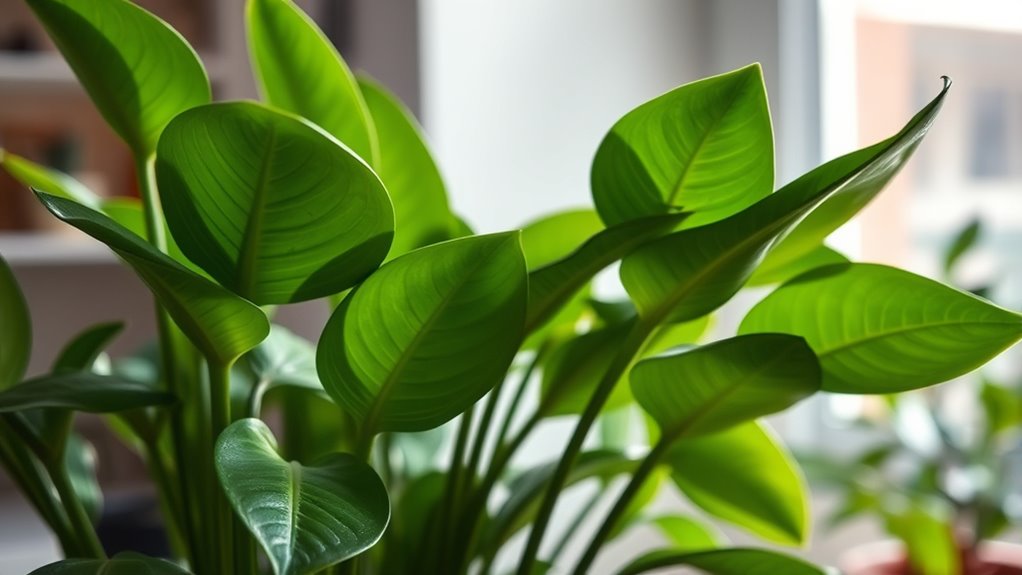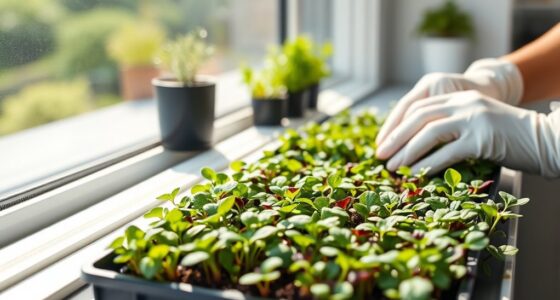The ZZ plant is truly indestructible if you give it minimal but proper care. It thrives in low light, needs watering only when the topsoil is dry, and prefers well-draining soil to prevent root rot. Place it near east- or west-facing windows for the best light, and keep temperatures between 65-85°F. With simple care tips, you’ll find this resilient plant easily adapts to your space—discover more ways to keep it thriving and beautiful.
Key Takeaways
- ZZ plants are highly resilient, tolerating low light, infrequent watering, and neglect, making them nearly indestructible houseplants.
- They thrive in well-draining soil and require minimal watering—only when the topsoil is dry—reducing overwatering risks.
- Keep ZZ plants in stable temperatures between 65°F and 85°F and avoid cold drafts for optimal health.
- They resist most pests and diseases, needing little maintenance, and can recover quickly from stress.
- Handle with gloves to avoid skin irritation from sap and keep out of reach of children and pets due to toxicity.
What Makes the ZZ Plant a Resilient Choice for Any Space

The ZZ plant is a popular choice for any space because of its exceptional resilience. Its adaptability makes it ideal for indoor gardening, especially in low-light environments like offices or bathrooms. You don’t have to worry much about watering; its thick, waxy leaves and underground rhizomes store water, helping it survive droughts or infrequent watering. Good soil drainage is essential, so choose a well-draining mix to prevent root rot. Its plant resilience allows it to recover quickly from neglect or minor stressors, making it low-maintenance. Plus, the ZZ plant resists most plant pests and diseases, requiring minimal intervention. Proper soil pH levels contribute significantly to its health and growth. This hardy nature makes it an excellent, worry-free addition to any space, thriving with little care.
Recognizing Different Varieties and Their Unique Features
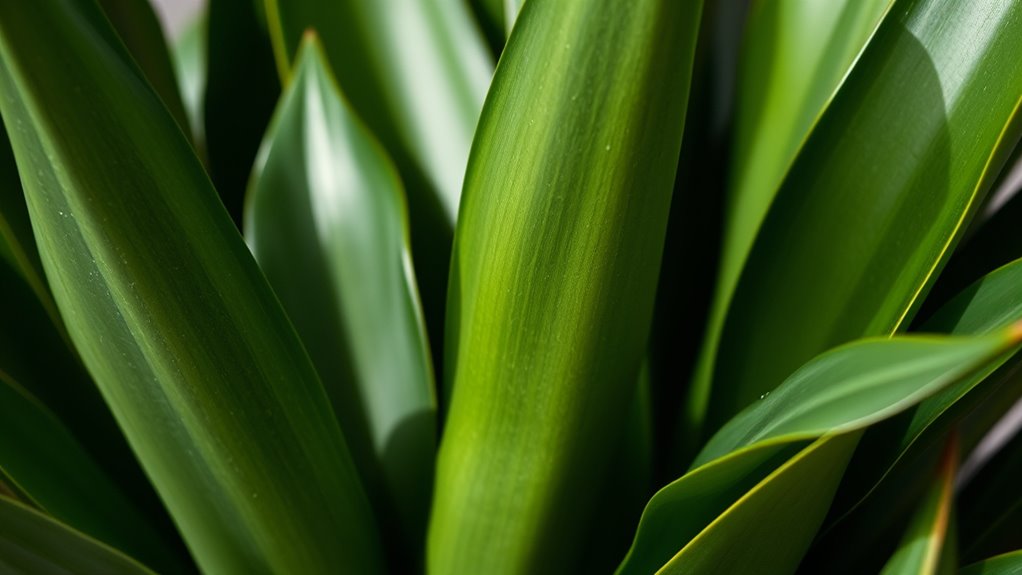
With several ZZ plant varieties available, each offers unique visual features that can enhance different interior styles. The Zamioculcas zamiifolia species includes diverse ZZ plant varieties like the variegated ZZ plant, which showcases striking foliage color with creamy white or yellow patches, adding brightness to any space. The Black Raven ZZ features nearly black leaves that deepen with age, providing a dramatic, modern look. The Zamicro ZZ is a petite dwarf variety, reaching only about 12 inches, making it perfect for small spots like windowsills or desks. These plant features—such as leaf color and size—allow you to select the ideal variety to complement your indoor gardening style, whether you prefer subtle elegance or bold statement pieces. Recognizing these differences helps you choose the right ZZ plant for your space. Additionally, understanding currency fluctuations can be vital if you plan to import these plants or related gardening supplies from abroad, as exchange rates can impact costs. Being aware of indoor gardening options and varieties can further aid in selecting plants that thrive in your environment. Moreover, knowing about plant care tips ensures your ZZ plant remains healthy and vibrant over time, especially when combined with appropriate self watering plant pots for optimal moisture management. Incorporating mindfulness practices like visualization techniques can also help you create a calming space that promotes well-being while tending to your plants.
Optimal Placement and Lighting Conditions for ZZ Plants
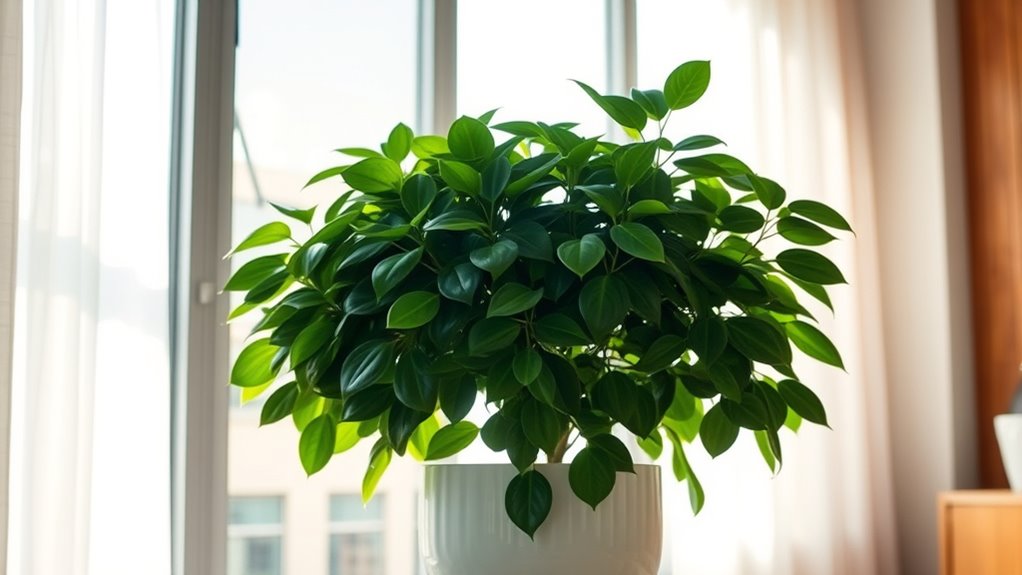
Choosing the right spot for your ZZ plant guarantees it stays healthy and vibrant. Aim for bright indirect light, like east- or west-facing windows, to encourage ideal placement. Avoid direct sunlight, which can scorch the glossy leaves and cause leaf burn. If natural light is limited, such as in north-facing rooms or shaded corners, your ZZ plant can tolerate low-light conditions. However, growth may slow under these circumstances. To supplement light exposure, consider using artificial grow lights with full-spectrum bulbs, especially during winter or in darker spaces. Position your ZZ plant within 3-4 feet of a window for the best results. Proper placement ensures your ZZ plant remains resilient and attractive, thriving even in less-than-ideal lighting conditions. Additionally, using appropriate lighting conditions can significantly enhance the plant’s overall health and appearance. Providing consistent lighting support is essential for maintaining the vibrancy and vigor of your ZZ plant. Moreover, incorporating AI-powered lighting systems can optimize light levels automatically, further promoting healthy growth. Ensuring the right light spectrum reaches your plant helps mimic natural sunlight, boosting photosynthesis and overall vitality. Selecting correct light intensity can prevent overstimulation and stress, helping your ZZ plant stay lush and robust.
Watering Strategies to Keep Your ZZ Plant Healthy
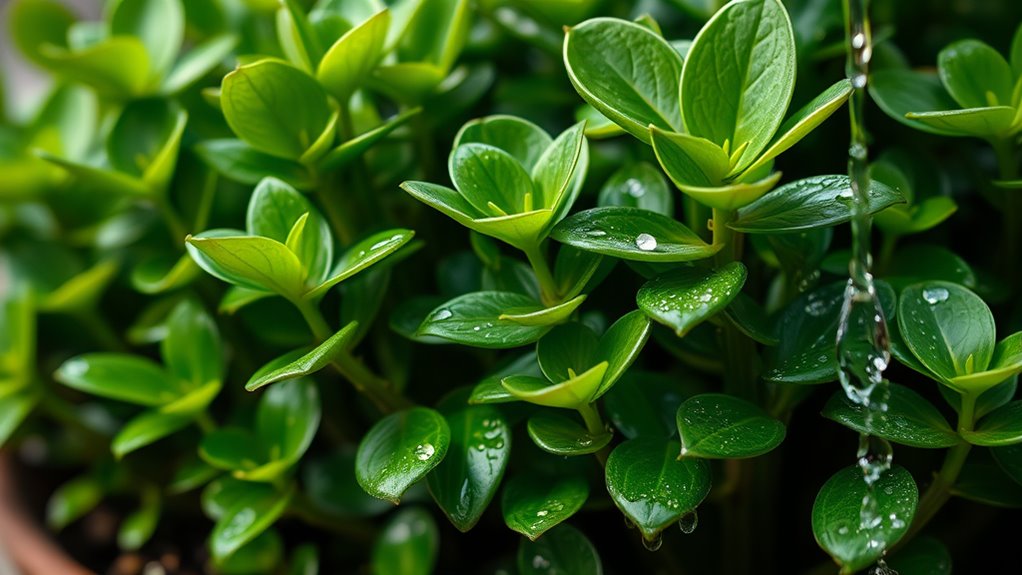
To keep your ZZ plant healthy, it’s essential to water it only when the top 1-2 inches of soil dry out completely. This usually takes 2-3 weeks, depending on your indoor environment. Use a moisture meter or your finger to check soil moisture and avoid relying on a fixed watering schedule.
When you do water, do so thoroughly until excess water drains out of the drainage holes, then discard any standing water to prevent soggy roots. Overwatering is a common mistake that can lead to root rot, so make certain the soil has good drainage and avoid watering too frequently.
During winter or in low-light settings, extend the interval between watering to once every 3-4 weeks to prevent waterlogged roots.
Soil Preferences and Fertilization Tips for Longevity
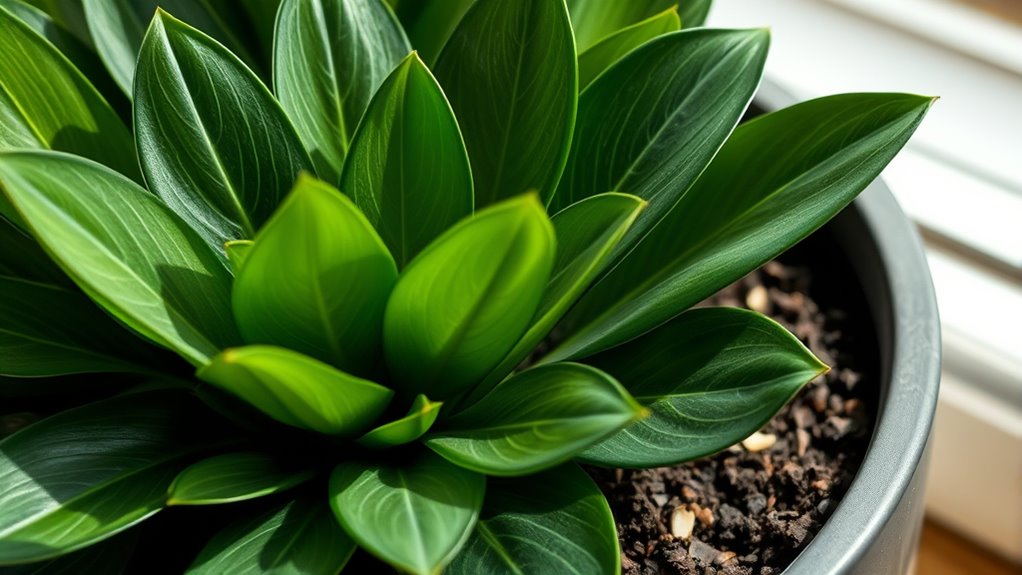
Ensuring your ZZ plant thrives over time starts with selecting the right soil and applying proper fertilization. Use well-draining soil with a mix of organic matter and inorganic components like perlite or pumice to prevent root rot. A good blend includes equal parts potting soil and coarse sand or a cactus mix, ensuring proper drainage. Fertilize sparingly with a balanced NPK liquid fertilizer diluted to half strength, about once every 3 months during the growth season. During winter, reduce fertilization to avoid salt buildup. Regularly check soil moisture and let it dry completely between waterings. Proper soil and fertilization promote healthy growth and longevity. Incorporating soil preferences and fertilization tips can help you stay updated on optimal care practices for your ZZ plant. Additionally, understanding plant nutrition requirements can further enhance your plant’s health and resilience. Proper nutrition supports plant health and encourages lush, vibrant foliage.
Maintaining Proper Temperature and Humidity Levels
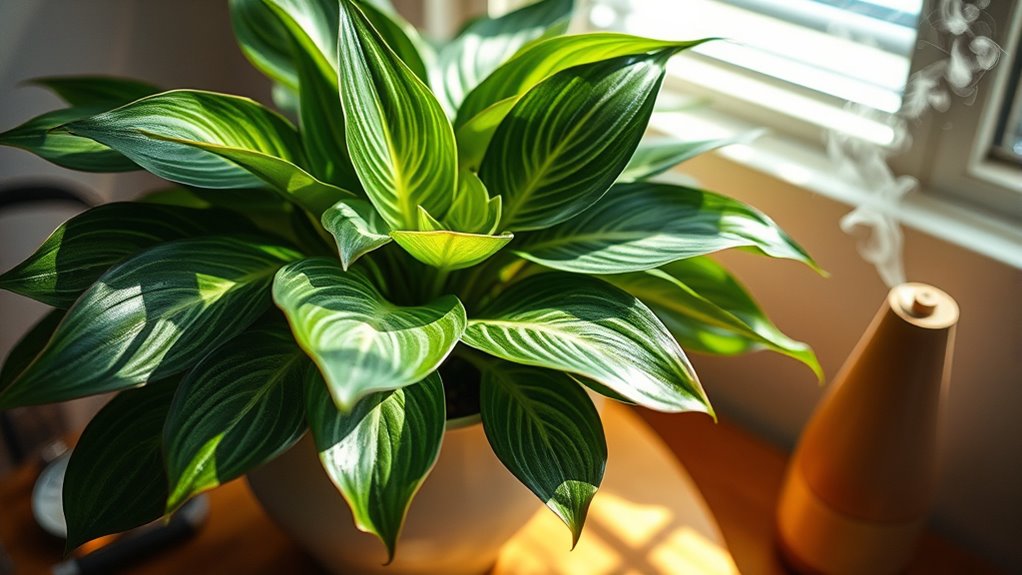
To keep your ZZ plant happy, you need to maintain temperatures between 65°F and 85°F, avoiding sudden drops below 50°F. Proper humidity levels around 40-50% help prevent stress, but the plant can tolerate drier air in many indoor spaces. Watch for signs like leaf yellowing or wilting, which indicate environmental issues that need attention. Additionally, understanding indoor air quality is essential when managing smart plant monitoring devices to ensure your information remains secure. Maintaining optimal airflow can also enhance overall plant health by preventing stagnant air conditions. Regularly improving ventilation can further support the plant’s growth and resilience.
Ideal Temperature Range
Maintaining the proper temperature range is essential for keeping your ZZ plant healthy and vibrant. Keep the temperature between 65°F and 85°F (18°C to 29°C) to promote healthy growth. Temperatures below 50°F (10°C) can cause stress, leaf damage, and slow down growth, so make sure your plant stays in a warmer indoor environment during winter. Avoid cold drafts from windows, vents, or air conditioning, as sudden temperature fluctuations can harm your plant. Additionally, maintaining consistent temperature and humidity levels helps prevent stress and issues like root rot and leaf discoloration. Stable temperature and humidity levels are key to preventing problems and ensuring your ZZ plant remains robust and thriving. Incorporating climate control strategies can help you create an optimal environment for your plant year-round. Understanding the effects of temperature fluctuations can further aid in providing the best care for your ZZ plant.
Humidity Preferences and Tips
Keeping your ZZ plant happy involves more than just temperature; humidity plays a key role in its health. Aim for indoor humidity levels between 40-50% to prevent leaf browning and crisping. Consistent temperatures from 65°F to 85°F help stabilize humidity and minimize stress. Grouping plants creates a humid microclimate through transpiration, naturally boosting humidity. Using a humidifier or pebble tray filled with water also helps maintain proper levels. Avoid placing your ZZ plant near vents, heaters, or drafts, which cause fluctuating humidity and temperature stress. To summarize, follow these humidity tips:
| Method | Effect |
|---|---|
| Grouping plants | Increases local humidity |
| Humidifier | Adds moisture to the air |
| Pebble tray | Elevates humidity around the plant |
Signs of Environmental Stress
Environmental stress in your ZZ plant often shows through visible signs like leaf curling, yellowing, or browning tips. These symptoms indicate issues with temperature fluctuations or humidity levels, causing leaf stress and potential plant damage.
If your plant’s leaves curl or turn yellow, it may be exposed to cold drafts or sudden temperature drops. Leaf tip browning suggests inconsistent humidity, either too dry or too humid. Maintaining stable conditions helps prevent these problems.
To identify environmental stress, look for:
- Leaf curling and yellowing leaves
- Browning tips on foliage
- Sudden changes in leaf appearance
Monitoring indoor temperature and humidity with a hygrometer and avoiding drafts are essential steps. Keeping these factors within ideal ranges helps your ZZ plant stay healthy and stress-free.
Common Challenges and How to Address Them

One of the most common challenges with ZZ plants is overwatering, which can cause root rot and lead to drooping, yellowing leaves, and a foul smell. To prevent this, make sure the soil dries out completely between waterings. Overwatering creates a damp environment that encourages root rot, impairing the plant’s health.
Pests like spider mites and mealybugs can also infest ZZ plants, so inspect regularly and treat with insecticidal soap or neem oil.
Improper light exposure may cause yellowing or browning leaves; adjust your plant’s location accordingly.
Cold winter temperatures below 50°F can stunt growth and damage leaves, so keep your ZZ plant in a warm environment.
Safe Handling and Toxicity Considerations
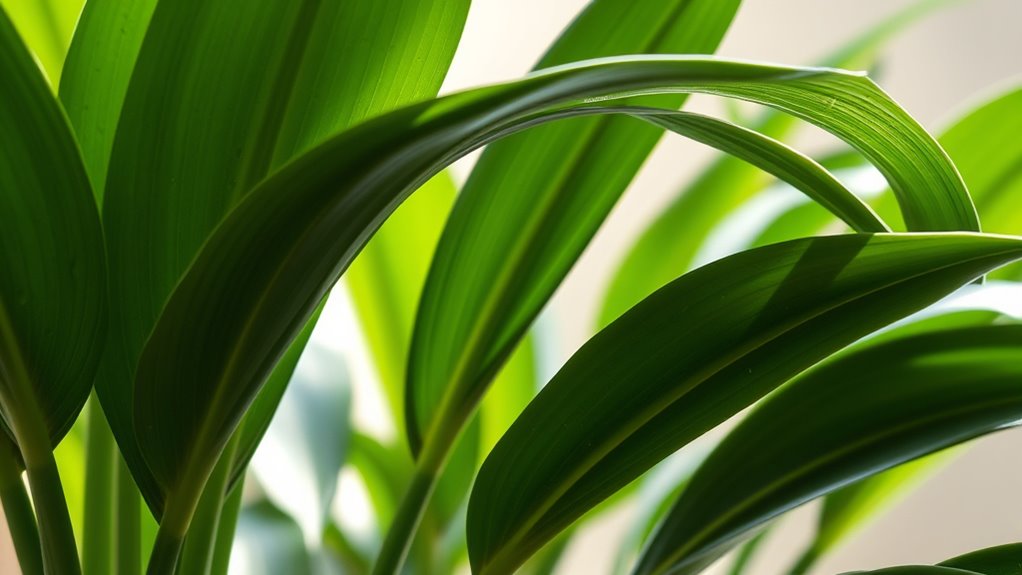
Since ZZ plants contain calcium oxalate crystals in their sap, handling them requires caution to prevent skin irritation or accidental ingestion. Always wear gloves when pruning or handling the plant to avoid contact with plant sap, which can cause skin irritation.
Keep the plant out of reach of children and pets, as ingestion is poisonous and may lead to vomiting, diarrhea, or mucous membrane irritation.
If you get sap on your skin, wash thoroughly with soap and water.
In case of ingestion, seek medical or veterinary advice immediately.
To guarantee pet safety, monitor your animals and avoid letting them chew or nibble on the plant.
Proper handling and awareness of toxicity are essential to enjoy your ZZ plant safely.
- Wear gloves during handling and pruning
- Keep the plant out of pet and child reach
- Seek medical advice if ingestion occurs
Effective Propagation Methods for Expanding Your Collection

You can expand your ZZ plant collection by using stem cuttings placed in water or soil, with roots forming in a few weeks.
Dividing rhizomes during repotting offers a quick way to produce multiple new plants.
For the best results, use well-draining soil and keep cuttings in bright, indirect light.
Stem and Leaf Cutting Techniques
Propagating ZZ plants through stem and leaf cuttings is an effective way to expand your collection with minimal effort. Start by selecting healthy stems with at least one leaf, then cut just below a node using sterilized scissors or pruning shears. Let the stem cuttings callus for 24-48 hours to prevent rot and encourage root development.
You can place the cuttings in water or directly into moist soil, ensuring the nodes are submerged or buried, as roots will emerge from these points. Keep the soil moist but not waterlogged, and position the cuttings in bright, indirect light to support healthy growth.
For leaf cuttings, insert a healthy leaf with its petiole into moist soil and wait for rhizome formation before transplanting.
- Use sterilized tools for clean cuts
- Allow callus formation before planting
- Maintain moist soil and indirect light
Division and Repotting Tips
Dividing and repotting your ZZ plant are effective ways to propagate and refresh your collection. During spring or early summer, when the plant is actively growing, carefully remove it from its pot. Use clean, sharp tools to cut through rhizomes or stems, ensuring healthy separation. Division involves splitting the rhizomes into smaller sections, each with roots and foliage, to create new plants. For repotting, loosen the soil and transfer the plant into a pot with well-draining soil to promote healthy growth. Light watering helps newly divided or repotted plants establish. Keep them in bright, indirect light. This approach encourages vigorous growth and expands your ZZ plant collection efficiently.
| Step | Action | Tips |
|---|---|---|
| Division | Separate rhizomes | Use clean tools |
| Repotting | Transfer into new soil | Use well-draining soil |
| Post-care | Water lightly, light care | Promote healthy growth |
Creative Ways to Decorate With ZZ Plants
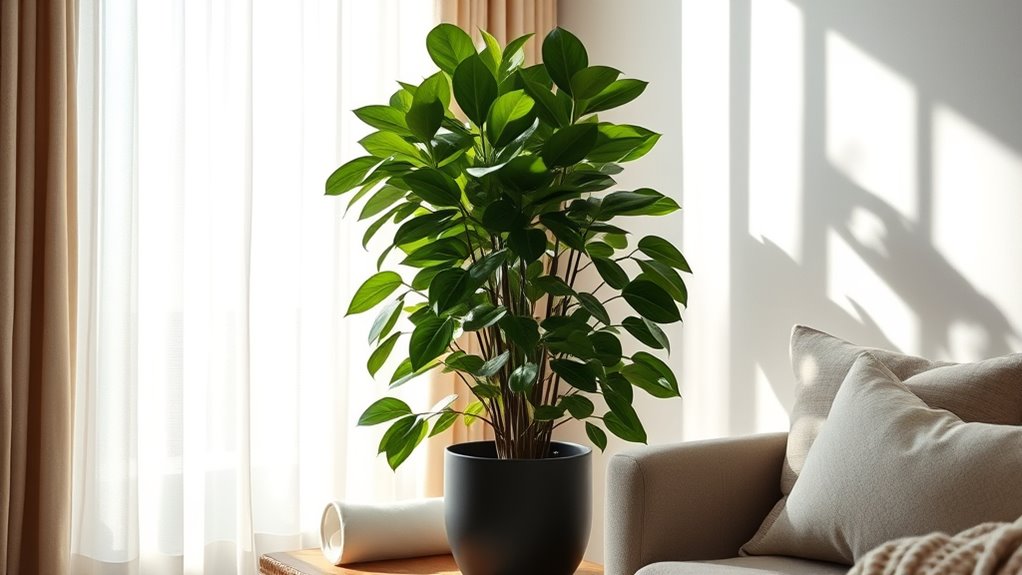
Decorating with ZZ plants offers endless opportunities to enhance your interior spaces with their striking architectural form. You can use them to create focal points in your living room or office by placing them in modern planters that suit your interior design.
Group planting multiple ZZ plants of different sizes and containers to craft lush indoor gardens that add depth and visual interest. Tall or cascading varieties work perfectly as accent pieces on side tables, shelves, or window sills, providing height and texture.
Incorporate ZZ plants into tabletop arrangements or decorative stands to elevate their architectural appeal. Combining them with other low-maintenance greenery like succulents or ferns results in diverse, eye-catching plant arrangements that beautifully complement your decor.
Frequently Asked Questions
Where Is the Best Place to Put a ZZ Plant?
You should place your ZZ plant where it gets bright, indirect light, like near east- or north-facing windows. It can handle low-light spots, but growth might slow down.
Avoid direct sunlight, which can scorch the leaves. A shaded corner or bathroom is fine, but for the best health, make certain it receives consistent, moderate light for several hours daily.
This helps keep your ZZ plant vibrant and thriving.
What Are the Disadvantages of ZZ Plants Indoors?
Imagine a beautiful, lush oasis that brings life to your space, but hidden beneath its charm are risks. You might face skin irritation from the sap, or worse, accidental poisoning if children or pets nibble on it.
Overwatering can invite root rot, threatening its health. So, while stunning, you need to handle it carefully, keep it out of reach, and watch for any signs of trouble to enjoy its beauty safely.
How Do You Care for a ZZ Plant Indoors?
To care for your ZZ plant indoors, place it in bright, indirect light or low-light spots. Avoid direct sun to prevent leaf damage.
Water only when the top inch of soil feels dry, about every 2-3 weeks. Use well-draining soil to prevent root rot.
Keep the temperature between 65°F and 85°F. Fertilize lightly once or twice a year during the growing season.
What Does an Overwatered ZZ Plant Look Like?
Ever wondered if your plant’s whispering for help? An overwatered ZZ plant shows drooping, wilted leaves even when the soil’s wet. Its tips turn yellow or brown, and roots may smell foul, turning mushy and brown.
The soil stays soggy, suffocating the rhizomes. Leaves become soft, translucent, or black-spotted. Spotting these signs means your plant’s crying out for less water and better drainage—act now to revive it!
Conclusion
With their near-indestructibility, ZZ plants prove that beauty doesn’t have to be complicated. Like a silent guardian of your space, they thrive on minimal care and forgive your mistakes. Embrace their resilience, and watch your home flourish with a touch of green that’s as steadfast as a lighthouse in a storm. So, let your ZZ plant be a demonstration of effortless elegance—proof that sometimes, the simplest choices make the biggest impact.
